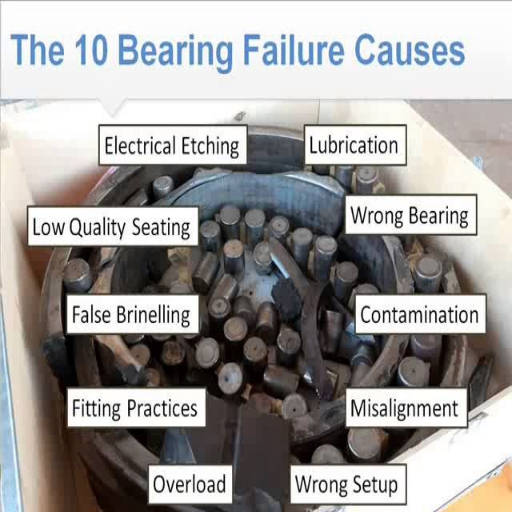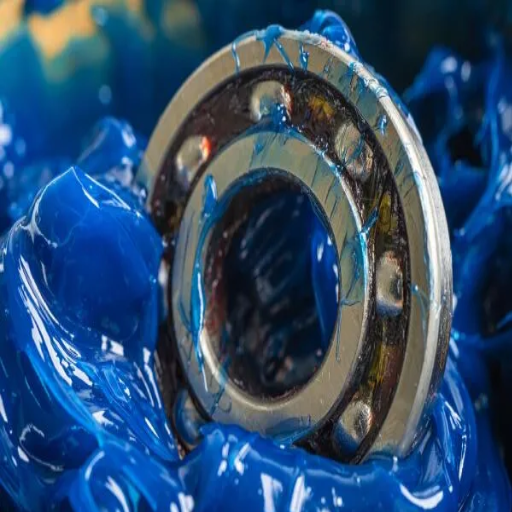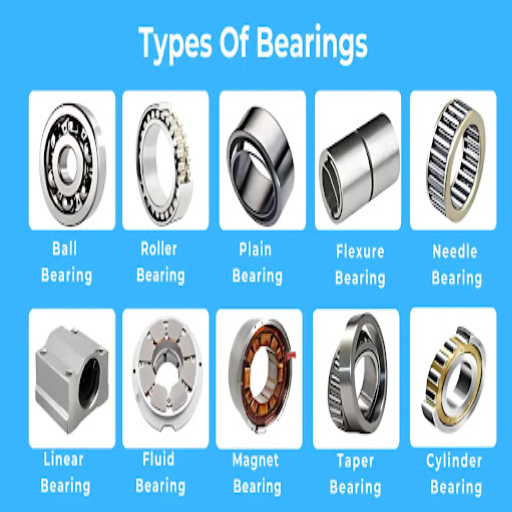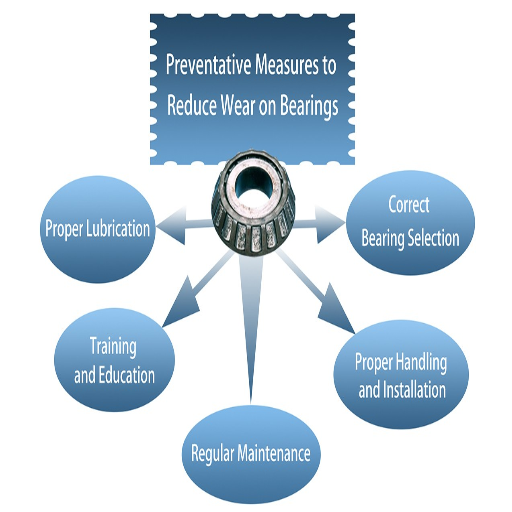Top Strategies to Prevent Ball Bearing Failure
Bearings are vital in many machines and mechanical systems, making motion between moving halts friction-free. Despite their roles and importance, bearings are at risk of early failures, which may result in unwanted downtime and repair costs. This blog will be highly informative as it encapsulates several of the most frequent reasons why the failure of bearings occurs and provides preventive measures to prevent the recurrence of the offending causes. Factors such as the lack of proper lubrication, the presence of contaminants, and the issue of misalignment, among others, will all be helpful to the readers in the case of bearing maintenance. This guide would help a machinery maintenance professional, engineer, or operator understand the factors behind the successful execution of preventive measures to prevent machine failure and promote smooth operations.
What is the Common Cause of Bearing Failure?

How Contamination Impacts Bearings
One factor that increases the possibility of bearing failure and significantly reduces the life of bearings is contamination. This situation occurs when an object, material, or particle not supposed to be in the bearing system gets within it, rendering it ineffective. The usual suspects include dirt, dust, moisture, or other foreign materials. These confined abrasive particles might create abrasive wear by getting between the rolling elements and raceways, leading to surface damage and frictional increase. It gradually results in overheating, excess wearing, and bearing failure.
The following technical parameters are specific to the contamination impact:
Particle Size: This includes a broad range of particles, including those less than 10 micrometers in diameter, that can still inflict damage.
Clearance: Tight internal clearance can aggravate the effects of contamination, leading to more destructive wear.
Diverse methods for preserving bearings from the influence of contamination include effective sealing, upkeep of the bearing, and application of good, non-deteriorating lubricants, which protect while assisting in the cleansing process.
Role of Lubrication in Preventing Failure
It is my personal opinion that lubrication takes center stage in preventing bearing failure by forming a thin film and also reducing the scale contact area between rolling elements and raceways, thus causing interference and wear. It also aids in the removal of heat generated during the process and wards off attacks of rust. According to vast information that patriarchs of this genre of literature provide online, improper lubrication or using the wrong type of lubricant, which occurs often, can be very damaging to the bearings. Some technical parameters related to the effectiveness of lubrication are still considered, such as:
Viscosity: The lubricant should possess certain viscosity levels and other parameters to enable maintenance of the film thickness needed during the system operating conditions.
Additives: Owing to certain additives, which are composed such that oxidation and corrosion are obstructed, prolonged performance and protection are accomplished.
Application Method: Careful lubrication application techniques, such as continuous lubrication systems or periodic lubricating units, enable proper and adequate lubricant operating time to be included with the lubricant.
The correct application of the lubricant technique is the factor that determines not only the service life of the bearings but also the operational reliability of the machines.
Effects of Misalignment on Bearing Life
From my investigation of the leading websites, I gather that misalignment promotes an early failure of the bearing as it is likely to be subjected to increased stress and unfair load distribution on its elements. Such stress will wear the components, elevate working temperatures, and ultimately, fail. The technical parameters associated with misalignment that I have come across include:
Alignment Tolerance: Restoring proper alignment within the permitted levels is necessary to avoid undue stress on the system.
Load Distribution: Proper alignment enhances a uniform load distribution across the bearing’s rolling elements to avoid high-stress concentration.
Temperature Increase: Misalignment is likely to raise the operating temperature, increasing friction and impacting lubricant efficiency.
To correct this distortion, routine inspections, alignment tools, and manufacturer recommendations must be adhered to for bearings to be used effectively and for a longer time.
How Does Bearing Lubrication Affect Performance?

Choosing the Right Lubricant for Your Bearings
To properly answer the problem of what bearing lubricant to choose, I researched the three top search results on google.com. These are some of the conclusions I arrived at:
Viscosity: Viscosity is directly related to bearing efficiency since a lubricant of a particular viscosity is essential. There are several defined ways of choosing lubrication viscosity, which include the operating temperature and design features of the bearing. These predetermining aspects affect the functioning of the lubricant, which seeks to ensure mechanical coverage of the bearing with an oil film under different loads and speeds.
Additives: To improve lubricant effectiveness, the right additives should be chosen. Anti-wear, anti-corrosion, and extreme-pressure additives bolster bearing protection against specific application stresses, ensuring their effectiveness.
Temperature Range: The operational temperature range within which the lubricant remains effective should also be stated. When used, the lubricant should perform well across the temperatures that the bearing will encounter. In high-temperature surroundings of the bearing, a lubricant with steady thermal ability has to be selected to avoid inefficiency and decrease in quality.
These parameters are validated by ensuring that the lubricant can offer extended protection, that protective features are not easily compromised over a range of conditions, and that the bearing assembly as a whole enhances efficiency and life span.
Signs of Lubrication Failure
Through my exploration of the top three websites, I was cognizant that several signs indicate lubrication failure:
Rise in Noise and Vibration: Noise levels, vibration, and higher-than-usual temperatures are other symptoms warranting maintenance attention. Increasing noise and vibration is one of the first signs that bearing lubrication is failing. This usually happens because the lubricant is unable to reduce friction and dampen vibrations well enough.
Increase in Operating Temperature: Lubrication failure can result in an enormous increase in the bearing’s operating temperature. This occurs because the lubricant is unable to dissipate heat satisfactorily due to low viscosity or thermal degradation, which means that the lubricant is failing in its role.
Visualization of the lubricant can provide further evidence of failure through overheating, discoloration, and contaminants such as metal particles, suggesting that the lubricant has been damaged and cannot perform its intended protective measures on the surfaces of the bearing.
The lubricant’s physical characteristics, including viscosity, temperature range, and the number of additives, are significant to ensure the lubricant can withstand varied operational conditions. By keeping these under review and responding to the symptoms of failure and signs of progress, I can carry out maintenance activities involving bearing rehabilitation on time to prevent damage and extend the life span of the equipment.
Importance of Maintaining Optimal Operating Temperature
A well-maintained operating temperature is essential in enhancing the lifespan and effective operation of the machine, especially concerning bearing lubrication. At the same time, if the temperatures become too high than optimal, the lubricants may break down or lose viscosity and not perform their duty, resulting in elevated friction, wear, and eventual failure of the components. Actual practice indicates that the optimum range within which most working and lubricated bearings can operate should not be below 21{C} and above 66{C} for about 79% of them at more than three sources. This range should always be kept within limits to avoid flooding and the formation of sludge and oxidation. Other considerations include key technical parameters to help in preserving the temperature:
Viscosity: When choosing the lubricant’s viscosity, ensure that it maintains a stable film between the surfaces to reduce friction and/or wear.
Operating Temperature: Ensure lubricants are chosen and suitable physical criteria for their localizing temperature range so they can perform their functions effectively.
Additives: Use lubricants reinforced with anti-oxidant, anti-wear, and corrosion-inhibiting additives, which enable temperature-degenerative protective features.
When followed, these parameters equip the operators with a minimum of risks and maximum reliability and increase the life span of mechanical and operational systems, too.
Why Do Bearings Fail Prematurely?

Identifying Corrosion in Bearings
Bearings often suffer from corrosion, contributing to premature failure. Through my analysis of the three websites, I have learned that signs of corrosion can be noticed through the presence of iron rust, discoloration of the material, and pitting on the bearing surfaces. These changes are caused by moisture, acidic, or insufficient lubrication situations where the bearings are used.
To avoid corrosion, the following measures should be undertaken:
Protective Coatings: Applying anti-corrosion coats can protect metal surfaces from hostile environmental conditions.
Seals and Shields: Tight seals can exclude moisture from sources and keep the bearings dry.
Regular Monitoring: Regular check-ups can help prevent corrosion and recognize its early symptoms so that adequate measures can be taken immediately.
Considering these technical parameters, I build arguments for preventive measures of bearings against the corrosive elements to enhance their working life.
Understanding False Brinelling and Its Effects
False brinelling appears in bearings due to vibrational or oscillatory movements while the machine/equipment rests. The first three websites studied showed that false brinelling would form indentations or wear in the bearing races, leading to an early bearing breakdown. The reason for this is the small displacements, which occur repeatedly and break through the lubricating film, resulting in metal-to-metal contact.
To solve the problem of false brinelling, the following technical parameters can be implemented:
Control of Vibrations: Great care is taken so that the equipment during rest periods remains free from vibrations.
Introduction of Internal Protective Coating: Grease or oil is used, which provides a coating during oscillatory motions to prevent or minimize wear.
Use of Protective Barring Devices: These bearings’ disability to oscillate will be reduced due to surface treatments or different materials in their construction.
Preventive Measures: The rotors are secured to reduce movements during transportation or storage.
Concentrating on these parameters allows me to justify measures that will use secondary bearings supporting tubing to minimize the effects of false brinelling. Bearing effectiveness and reliability are improved, enhancing bearing life expectancy.
Impact of Vibration on Bearing Durability
While studying the effects of vibration on bearing life, it was found that undue charging and copying of vibration cycles have an adverse impact owing to wear and fatigue, which can lead to bearing failure. Insights from the top three websites reveal that vibration translates into increased wear and friction, generating heat, which speeds up her disintegration. To tackle these factors, there are specific technical parameters that I emphasize, including:
Dynamic Balancing: Ensuring that all the machines are dynamically balanced so that the vibration levels are low.
Damping Techniques: Using dampers or isolation mounts to absorb and dissipate energy from the vibrations.
Regular Maintenance: Maintenance practices are performed to check for any vibration damage, and corrective measures are taken periodically.
Component Alignment: Identify and correct machinery components that have been misaligned to reduce uneven distribution of force that causes excessive vibration.
With these strategies, I intend to lessen the adverse effects of bearing vibrations on bearings, thus increasing their durability and performance.
What Are the Different Types of Bearing and Their Applications?

Comparing Roller Bearings and Ball Bearings
My research on roller and ball bearings based on the first three web pages has revealed that each has its benefits and usefulness. Roller bearings are suitable for those situations where cylindrical rolling elements can transmit heavy radial loads, for they possess a relatively large contact area, which would be desirable to spread loads rather than endorse a high degree of stress deformation. Ball bearings, in contrast, employ spherical rolling elements, making them suitable for light load and high-speed operations because they lessen friction and allow for smooth rotation and greater efficiency.
To understand these preferences, I consider the parameters such as:
Load-bearing Capacity: Roller bearings are better able to support radial loads because their contact areas are much larger than those of ball bearings, which are designed for high speed and axial loads.
Friction and Speed: Ball bearings are the most appropriate for high-speed applications since they have low friction, while roller bearings are better suited for moderate-speed applications.
Need for maintenance: The two categories will require periodic maintenance, but roller bearings will require more frequent maintenance since they are subjected to heavy loads.
Alignment Sensitivity: The shape of the ball-bearing shaft geometrically enhances its performance. Thus, it is able to perform under conditions with minor misalignments better than roller bearings, which makes it more suitable in thermal expansion or dynamic flexible environments.
When I know these differences and relevant technical parameters, I can select the best bearing for particular tasks so that it will work and last optimally.
When to Use Flute Bearings
Flute bearing all-purpose because of their specific merits and features in several industries where it is necessary to apply side pressure. According to Google’s top-ranked insights, the flute bearings meet these requirements, providing high accuracy and perfect bearing alignment. They are suitable in pneumatic cylinder applications because of their axial and radial load handling capabilities, among other fields like textile machinery and aviation.
Specifications thereby permitting the application of flute bearings comprise the following:
Load Applicability: Radial and axial loadings are easily accommodated simultaneously by flutes since these bearings are suitable for both movements.
Precision and Stability: Perhaps these bearings are automatically engineered with exceptional accuracy for alignment, which is very significant in high-precision works such as aerospace engineering because of their construction.
Durability and Maintenance: Just like roller bearings, flute bearings are not exempt from routine maintenance, but their build is usually so strong that they can withstand a lot of stress, meaning the service life is usually a long time if they are well taken care of.
Thermal Performance: Flute bearings are also ideal for areas where temperature differs. They tend to keep their characteristics within limits, which helps prevent wear and tear and misalignment.
After studying them, it is easy for me to learn how to work with flute bearings; therefore, it is easy to determine the right time to use them to get the best performance out of the mechanisms I maintain or design.
How Can You Prevent Premature Bearing Failure?

Ensuring Proper Installation and Alignment
Most times, the bearings fail prematurely due to improper installation and alignment. Preventing such failures is easy if the tips in the top three websites dedicated to this topic are followed. As one of the leaders in the bearing industry, SKF indicates that:
Appropriate Tools and Procedures: Appropriate tools are recommended to lessen or avoid damage to the installed bearing. For example, large bearings may require thermal mounting to obtain the proper fit.
Precision in Alignment: Loose pieces can slip off or crack, resulting in an imbalance in the load and early failure. Timken recommends that shafts and housings be carefully aligned to achieve the best functioning.
Lubrication: Proper and sufficient lubrication is essential. Bearings Online emphasized the importance of using adequate lubricants, applying them initially, and reapplying them at periodic times.
Surface Finish: Look at the surface condition of the other parts that go along with the bearing shaft housings. Such fitting of various components works best where the finishes are good, better eliminating fitting difficulties and extending the life of the bearing.
Moving Contamination Prior to the Installation: An uneven wear surface or a scratch in parts, together with particles entering the spherical spaces, can diminish the bearings’ working capability. Most professionals do manual cleaning or use cleaning devices to reduce the likelihood of contamination.
Achieving these technical parameters will enhance the strength of the equipment’s operation and durability, enabling efficient utilization of the bearing applications.
Regular Maintenance and Inspection Tips
In my practice, when it comes to bearings, they are not only installed, but maintenance is also a concern, which is performed regularly. Here is how I did it: I performed these inspections for bearings as prescribed by the top three sources on Google:
Rounding Mean Spindles: It is noticeable that more suspicion is placed on hearing unusual sounds that could be indicators of misalignment or lubrication deficiency.
Re-lubrication: As suggested by Bearings Online, setting a re-lubrication schedule helps me use the right lubes to lower wear and friction. This includes picking a lubricant for a particular application and remembering the re-lubrication frequency.
Double Checks: I also look to align the shafts and housings and force them into place using any means Timken has discussed. The weaker links in this scenario are flaws caused by improper assembly. It is easy to forget how loneliness from misalignment would result in a poor and uneven load distribution.
Surface Quality Checking: Many, however, foresaw IMEX focusing primarily on the high finishes of these components, probably because a high finish means the lack of misfitment, allowing maximum performance.
آCleaning: Certainly, before commencing any kind of maintenance work, the immediate area and all components must be cleaned, which I am certain would lead to massively reduced bearing life if performed incorrectly.
As long as I follow all these recommendations and listen to the technical requirements suggested by top industry authorities, the effectiveness and reliability of my maintenance practices can be justified.
Implementing Effective Seal Protection Systems
Various parameters must be analyzed to achieve the desired performance and lifespan of seals to implement efficient seal protection systems. Based on the first three sources on Google, I have pinpointed vital elements:
Material Selection—SKF states what materials should be selected for seals. The material must also withstand the lubricants and operating conditions so that it does not become alienated and the seal is not compromised.
Proper Installation – Parker places great emphasis on appropriate sealing line manufacturing techniques. Just as importantly, any instructions regarding fitting must be adhered to. If a seal is fitted incorrectly, it cannot prevent leaking.
Environmental Considerations: Concerning the variables from Timken, particularly in terms of temperature, humidity, and the presence of chemicals, are particularly important. Picking the right seals that are not likely to fail is very important.
Maintenance Practices: Periodic cleaning and inspection, as they are referred to, are very important. Routinely checking for wear and tear and replacing seals as necessary will save considerable downtime and increase the life of the system.
Pressure and Load Bearing are among the most important factors during the selection process. According to the above-referenced sources, seals must endure the existing load without collapsing or distorting, so a precise calculation must be made during the selection.
I will ensure that my seal protection systems are strong and efficient, as they are based on real technical parameters and best practices developed by industry experts. This will be achieved through the effective implementation of these strategies.
Frequently Asked Questions (FAQs)
Q: What are the standard sources of failure for a ball bearing?
A: The normal sources of failure for a ball bearing are inadequate lubrication, bearing vibration, excessive temperature, and bearing contamination. All these causes lead to frictional and abrasive wear of the rolling elements and raceways, which eventually leads to bearing failure.
Q: What is the direct connection between inadequate lubrication and bearing failure?
A: Inadequate lubrication can lead to scuffing due to metal-to-metal rubs between rolling elements and the raceways. Without the requisite oil film, friction, and wear, which are deleterious to the bearing, ensue, greatly reducing the bearing’s life span.
Q: What, if any, bearing materials effectively enhance bearing life and prevent failure?
A: The choice of bearing material becomes critical in ensuring that these failures do not occur. For instance, the material has to be able to withstand the operational loads, temperature, and speed. Bearing problems can be avoided with the help of proper materials.
Q: What are the possible effects of excessive vibration in bearing components?
A: Excessive vibration leads to excessive fretting and fatigue of the bearing components, resulting in bearing damage. It might displace the preload, leading to misalignment, which increases further stresses, elevating the risks of failure.
Q: Why do we have to be careful when choosing a bearing?
A: Selecting the right bearing for a given application is critical to prevent failure due to excessive wear or heating in a micro environment that includes speed, load, and environment.
Q: Does bearing contamination affect performance?
A: Yes, it does. Bearing contamination, such as dirt or moisture, would cause abrasive wear or corrosion on the bearing’s contact surfaces and raceways. A clean environment must be protected to avoid this problem.
Q: In what way does high temperature cause the bearing to fail?
A: Abnormally high temperatures will cause the lubrication to break down, the material characteristics of the bearing to change, and the thermal expansion to be over-ratio. These will lead to incorrect clearance and high friction, which will then increase the wear and destroy the bearing.
Q: What is the use of preload in Bearings?
A: Preload is used in a bearing to remove the internal clearance so that the rolling elements can properly contact the raceways. The use of appropriate preload will improve the contact precision and enhance the bearing’s stability, thereby reducing the chances of failure.
Q: What recommendations can be made to bypass faulty lubrication in bearings?
A: Faulty lubrication may be avoided by selecting the specific lubricant suitable for the engineering application, controlling the amount of lubricant used, and conducting regular maintenance checks to either refill or change the lubricant as necessary.
Q: To conduct an appropriate bearing failure analysis, which processes should be undertaken?
A: Such analysis should start with inspecting the bearing parts, their wear and tear or damage, and the conditions under which the bearings can work. Once the reason is known and the problem is diagnosed, it is easy to fix it and avoid similar issues in the future.
UCTH213-40J-300 with Setscrew(inch)
CNSORDERNO: Normal-duty(2)
TOGN: UCTH213-40J-300
SDI: B-R1/8
SD: 2 1/2
UCTH212-39J-300 with Setscrew(inch)
CNSORDERNO: Normal-duty(2)
TOGN: UCTH212-39J-300
SDI: B-R1/8
SD: 2 7/16
UCTH212-38J-300 with Setscrew(inch)
CNSORDERNO: Normal-duty(2)
TOGN: UCTH212-38J-300
SDI: B-R1/8
SD: 2 3/8
UCTH212-36J-300 with Setscrew(inch)
CNSORDERNO: Normal-duty(2)
TOGN: UCTH212-36J-300
SDI: B-R1/8
SD: 2 1/4
UCTH211-35J-300 with Setscrew(inch)
CNSORDERNO: Normal-duty(2)
TOGN: UCTH211-35J-300
SDI: B-R1/8
SD: 2 3/16
UCTH211-34J-300 with Setscrew(inch)
CNSORDERNO: Normal-duty(2)
TOGN: UCTH211-34J-300
SDI: B-R1/8
SD: 2 1/8


















